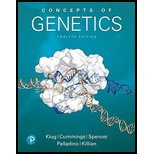
EBK CONCEPTS OF GENETICS
12th Edition
ISBN: 9780134818979
Author: Killian
Publisher: YUZU
expand_more
expand_more
format_list_bulleted
Concept explainers
Question
Chapter 6, Problem 4CS
Summary Introduction
To determine: The ethical responsibilities of a pediatrician for the present and future patients to provide effective treatment in the form of antibiotics.
Introduction: The ability of microorganisms or bacteria to resist the effect of the antibiotics to which they were once sensitive, is known as antibiotic resistance. Antibiotic resistance occurs when the bacteria changes and become resistant to chemical or drugs or antibiotics.
Expert Solution & Answer
Want to see the full answer?
Check out a sample textbook solution
Students have asked these similar questions
Standard Concentration (caffeine) mg/L
Absorbance Reading
10
0.322
20
0.697
40
1.535
60
2.520
80
3.100
Please draw in the missing answer, thank you
Please fill in all blank questions, Thank you
Chapter 6 Solutions
EBK CONCEPTS OF GENETICS
Ch. 6 - When the interrupted mating technique was used...Ch. 6 - In a transformation experiment involving a...Ch. 6 - In complementation studies of the rII locus of...Ch. 6 - A 4-month-old infant had been running a moderate...Ch. 6 - Prob. 2CSCh. 6 - Prob. 3CSCh. 6 - Prob. 4CSCh. 6 - HOW DO WE KNOW? In this chapter, we have focused...Ch. 6 - Review the Chapter Concepts list on p. 123. Many...Ch. 6 - With respect to F+ and F bacterial matings, answer...
Ch. 6 - List all major differences between (a) the F+ F...Ch. 6 - Describe the basis for chromosome mapping in the...Ch. 6 - In general, when recombination experiments are...Ch. 6 - Why are the recombinants produced from an Hfr F...Ch. 6 - Describe the origin of F bacteria and merozygotes.Ch. 6 - In a transformation experiment, donor DNA was...Ch. 6 - Describe the role of heteroduplex formation during...Ch. 6 - Explain the observations that led Zinder and...Ch. 6 - Prob. 12PDQCh. 6 - Two theoretical genetic strains of a virus (abc...Ch. 6 - The bacteriophage genome consists of many genes...Ch. 6 - If a single bacteriophage infects one E. coli cell...Ch. 6 - A phage-infected bacterial culture was subjected...Ch. 6 - In recombination studies of the rII locus in phage...Ch. 6 - In an analysis of rII mutants, complementation...Ch. 6 - If further testing of the mutations in Problem 18...Ch. 6 - Using mutants 2 and 3 from Problem 19, following...Ch. 6 - During the analysis of seven rII mutations in...Ch. 6 - In studies of recombination between mutants 1 and...Ch. 6 - Prob. 23ESPCh. 6 - An Hfr strain is used to map three genes in an...Ch. 6 - A plaque assay is performed beginning with 1 mL of...Ch. 6 - In a cotransformation experiment, using various...Ch. 6 - For the experiment in Problem 26, another gene, g,...Ch. 6 - Bacterial conjugation, mediated mainly by...Ch. 6 - A study was conducted in an attempt to determine...
Knowledge Booster
Learn more about
Need a deep-dive on the concept behind this application? Look no further. Learn more about this topic, biology and related others by exploring similar questions and additional content below.Similar questions
- please fill in missing parts , thank youarrow_forwardplease draw in the answers, thank youarrow_forwarda. On this first grid, assume that the DNA and RNA templates are read left to right. DNA DNA mRNA codon tRNA anticodon polypeptide _strand strand C с A T G A U G C A TRP b. Now do this AGAIN assuming that the DNA and RNA templates are read right to left. DNA DNA strand strand C mRNA codon tRNA anticodon polypeptide 0 A T G A U G с A TRParrow_forward
- Please identify the curve shown below. What does this curve represent? Please identify A, B, C, D, and E (the orange oval). What is occurring in these regions?arrow_forwardPlease identify the test shown here. 1) What is the test? 2) What does the test indicate? How is it performed? What is CX? 3) Why might the test be performed in a clinical setting? GEN CZ CX CPZ PTZ CACarrow_forwardDetermine how much ATP would a cell produce when using fermentation of a 50 mM glucose solution?arrow_forward
- Determine how much ATP would a cell produce when using aerobic respiration of a 7 mM glucose solution?arrow_forwardDetermine how much ATP would a cell produce when using aerobic respiration to degrade one small protein molecule into 12 molecules of malic acid, how many ATP would that cell make? Malic acid is an intermediate in the Krebs cycle. Assume there is no other carbon source and no acetyl-CoA.arrow_forwardIdentify each of the major endocrine glandsarrow_forward
arrow_back_ios
SEE MORE QUESTIONS
arrow_forward_ios
Recommended textbooks for you
 Biology 2eBiologyISBN:9781947172517Author:Matthew Douglas, Jung Choi, Mary Ann ClarkPublisher:OpenStax
Biology 2eBiologyISBN:9781947172517Author:Matthew Douglas, Jung Choi, Mary Ann ClarkPublisher:OpenStax Human Heredity: Principles and Issues (MindTap Co...BiologyISBN:9781305251052Author:Michael CummingsPublisher:Cengage Learning
Human Heredity: Principles and Issues (MindTap Co...BiologyISBN:9781305251052Author:Michael CummingsPublisher:Cengage Learning Biology: The Dynamic Science (MindTap Course List)BiologyISBN:9781305389892Author:Peter J. Russell, Paul E. Hertz, Beverly McMillanPublisher:Cengage Learning
Biology: The Dynamic Science (MindTap Course List)BiologyISBN:9781305389892Author:Peter J. Russell, Paul E. Hertz, Beverly McMillanPublisher:Cengage Learning Principles Of Radiographic Imaging: An Art And A ...Health & NutritionISBN:9781337711067Author:Richard R. Carlton, Arlene M. Adler, Vesna BalacPublisher:Cengage Learning
Principles Of Radiographic Imaging: An Art And A ...Health & NutritionISBN:9781337711067Author:Richard R. Carlton, Arlene M. Adler, Vesna BalacPublisher:Cengage Learning

Biology 2e
Biology
ISBN:9781947172517
Author:Matthew Douglas, Jung Choi, Mary Ann Clark
Publisher:OpenStax

Human Heredity: Principles and Issues (MindTap Co...
Biology
ISBN:9781305251052
Author:Michael Cummings
Publisher:Cengage Learning

Biology: The Dynamic Science (MindTap Course List)
Biology
ISBN:9781305389892
Author:Peter J. Russell, Paul E. Hertz, Beverly McMillan
Publisher:Cengage Learning



Principles Of Radiographic Imaging: An Art And A ...
Health & Nutrition
ISBN:9781337711067
Author:Richard R. Carlton, Arlene M. Adler, Vesna Balac
Publisher:Cengage Learning
genetic recombination strategies of bacteria CONJUGATION, TRANSDUCTION AND TRANSFORMATION; Author: Scientist Cindy;https://www.youtube.com/watch?v=_Va8FZJEl9A;License: Standard youtube license